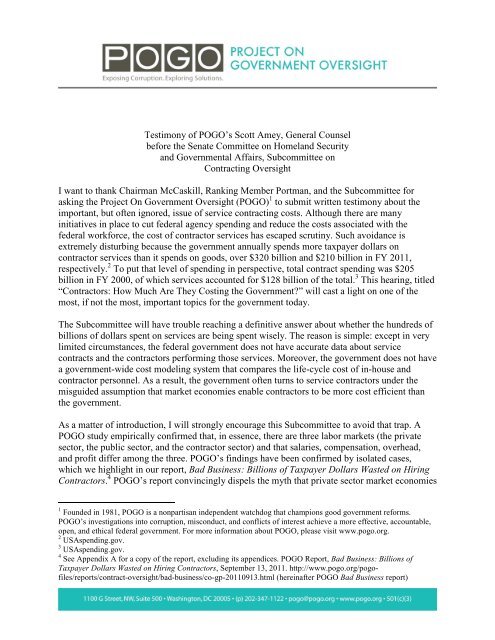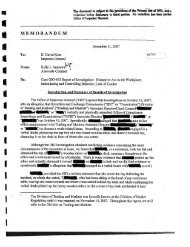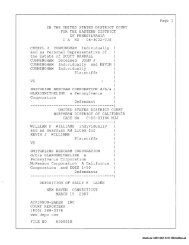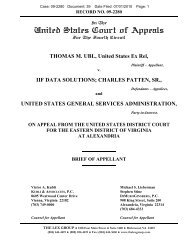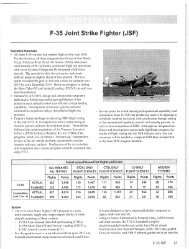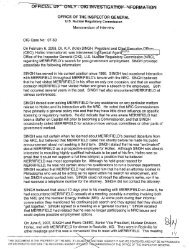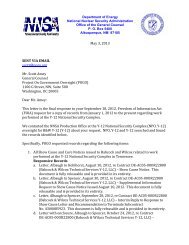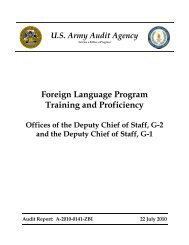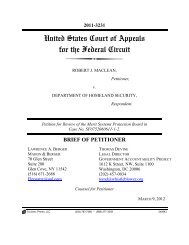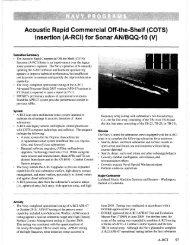SA McCaskill Cost Hearing Final 03 29 12 - U.S. Senate Homeland ...
SA McCaskill Cost Hearing Final 03 29 12 - U.S. Senate Homeland ...
SA McCaskill Cost Hearing Final 03 29 12 - U.S. Senate Homeland ...
Create successful ePaper yourself
Turn your PDF publications into a flip-book with our unique Google optimized e-Paper software.
Testimony of POGO’s Scott Amey, General Counsel<br />
before the <strong>Senate</strong> Committee on <strong>Homeland</strong> Security<br />
and Governmental Affairs, Subcommittee on<br />
Contracting Oversight<br />
I want to thank Chairman <strong>McCaskill</strong>, Ranking Member Portman, and the Subcommittee for<br />
asking the Project On Government Oversight (POGO) 1 to submit written testimony about the<br />
important, but often ignored, issue of service contracting costs. Although there are many<br />
initiatives in place to cut federal agency spending and reduce the costs associated with the<br />
federal workforce, the cost of contractor services has escaped scrutiny. Such avoidance is<br />
extremely disturbing because the government annually spends more taxpayer dollars on<br />
contractor services than it spends on goods, over $320 billion and $210 billion in FY 2011,<br />
respectively. 2 To put that level of spending in perspective, total contract spending was $205<br />
billion in FY 2000, of which services accounted for $<strong>12</strong>8 billion of the total. 3 This hearing, titled<br />
“Contractors: How Much Are They <strong>Cost</strong>ing the Government?” will cast a light on one of the<br />
most, if not the most, important topics for the government today.<br />
The Subcommittee will have trouble reaching a definitive answer about whether the hundreds of<br />
billions of dollars spent on services are being spent wisely. The reason is simple: except in very<br />
limited circumstances, the federal government does not have accurate data about service<br />
contracts and the contractors performing those services. Moreover, the government does not have<br />
a government-wide cost modeling system that compares the life-cycle cost of in-house and<br />
contractor personnel. As a result, the government often turns to service contractors under the<br />
misguided assumption that market economies enable contractors to be more cost efficient than<br />
the government.<br />
As a matter of introduction, I will strongly encourage this Subcommittee to avoid that trap. A<br />
POGO study empirically confirmed that, in essence, there are three labor markets (the private<br />
sector, the public sector, and the contractor sector) and that salaries, compensation, overhead,<br />
and profit differ among the three. POGO’s findings have been confirmed by isolated cases,<br />
which we highlight in our report, Bad Business: Billions of Taxpayer Dollars Wasted on Hiring<br />
Contractors. 4 POGO’s report convincingly dispels the myth that private sector market economies<br />
1<br />
Founded in 1981, POGO is a nonpartisan independent watchdog that champions good government reforms.<br />
POGO’s investigations into corruption, misconduct, and conflicts of interest achieve a more effective, accountable,<br />
open, and ethical federal government. For more information about POGO, please visit www.pogo.org.<br />
2<br />
U<strong>SA</strong>spending.gov.<br />
3<br />
U<strong>SA</strong>spending.gov.<br />
4<br />
See Appendix A for a copy of the report, excluding its appendices. POGO Report, Bad Business: Billions of<br />
Taxpayer Dollars Wasted on Hiring Contractors, September 13, 2011. http://www.pogo.org/pogofiles/reports/contract-oversight/bad-business/co-gp-20110913.html<br />
(hereinafter POGO Bad Business report)
necessarily allow contractors to perform government services at a cost savings to the<br />
government. The reality is that there are no generalizations that withstand scrutiny as to which<br />
market sector provides the optimal cost efficiency for any service area, no less all service areas.<br />
As a result, the federal government must, on a case-by-case basis, analyze whether it is more<br />
appropriate and cost efficient to employ government or contractor employees.<br />
The purpose of this hearing is to examine whether and how cost information is used by<br />
government agencies to make decisions about whether work should be performed by federal<br />
employees or contractors. Throughout this testimony, I will expand on the lack of personnel and<br />
cost data and what needs to be done to improve the system. POGO truly believes that if simple<br />
fixes are made, the government will save billions of dollars without expanding or reducing the<br />
size of the total federal workforce, which includes government and contractor employees.<br />
Today, witnesses will likely testify about two comparative cost models that are currently used to<br />
determine whether it is less costly to have private contractors perform government services,<br />
OMB Circular A-76 and the Defense Department’s Directive-Type Memorandum (DTM) 09-<br />
007, “Estimating and Comparing the Full <strong>Cost</strong>s of Civilian and Military Manpower and Contract<br />
Support.” 5 Those models are utilized, however, in only a small percentage of cases where the<br />
government contracts for services. In a vast majority of those instances, the models demonstrated<br />
that contractors were unable to accord any savings; indeed, were the government to transfer<br />
government services to contractors, the government would incur excessive costs. But even these<br />
models have been the subject of criticism for their failure to provide the government with an<br />
effective cost modeling system that accurately reflects all the relevant cost factors. 6 Because it<br />
does not approach the state-of-the-art systems employed by sophisticated business enterprises,<br />
the government limits its ability to make competent human capital planning decisions.<br />
I hope that this written testimony provides the Subcommittee with useful information about the<br />
government’s current inability to evaluate service contracting costs. More importantly, I hope<br />
this testimony will make clear what is missing in the current system and how to begin rectifying<br />
systematic flaws that cost taxpayers billions of dollars each year. So much is unknown about the<br />
true size and cost of both the government and contractor workforce. Congress must pass<br />
legislation that will create an effective government-wide cost modeling system and overhaul<br />
5 Federal law requires that the “Secretary of Defense shall use the least costly form of personnel consistent with<br />
military requirements and other needs of the Department,” which includes considering converting work from<br />
military, civilian, or private contract. 10 U.S.C. 1<strong>29</strong>a. http://uscode.house.gov/uscodecgi/fastweb.exe?getdoc+uscview+t09t<strong>12</strong>+75+1++%28%<strong>29</strong>%20%20AND%20%28%2810%<strong>29</strong>%20ADJ%20USC%2<br />
9%3ACITE%20AND%20%28USC%20w%2F10%20%281<strong>29</strong>a%<strong>29</strong>%<strong>29</strong>%3ACITE<br />
6 Congressional Research Service, Defense Outsourcing: The OMB Circular A-76 Policy (RL3<strong>03</strong>92), June 30, 2005,<br />
pp. 4-6. http://www.fas.org/sgp/crs/natsec/RL3<strong>03</strong>92.pdf (Downloaded April 20, 2011); In addition, a Center for<br />
Strategic and International Studies (CSIS) report highlights the inherent problems with government life-cycle cost<br />
comparison models and appropriate overhead rates, and proposed a cost-estimating methodology. Although the<br />
report discusses a comprehensive cost estimation methodology that should be used to create a baseline for making<br />
more accurate cost comparisons, it is silent on all the costs the government incurs, above and beyond fixed billing<br />
rates, associated with the award, administration, and oversight of service contracts. Center for Strategic and<br />
International Studies, DoD Workforce <strong>Cost</strong> Realism Assessment, May 2011, pp. 11-19.<br />
http://csis.org/files/publication/110517_Berteau_DoDWorkforce<strong>Cost</strong>_Web.pdf (Downloaded May 18, 2011)<br />
(hereinafter DoD Workforce <strong>Cost</strong> Realism Assessment)<br />
2
service contract inventories. 7 Such legislation will enable decision makers to identify costly<br />
service contracts and provide agencies with the tools necessary to avoid transferring government<br />
services to contractors at unjustifiable costs.<br />
Service Contracting Myths<br />
POGO has watched federal contract award dollars dramatically increase from just over $200<br />
billion in FY 2000 to over $530 billion in FY 2011. 8 At the same time, service contract dollars<br />
have also been escalating at a rapid pace. There is no doubt that the increase in contract spending<br />
is the direct result of 9/11, Hurricanes Katrina, Rita, and Wilma, and the wars in Iraq and<br />
Afghanistan. However, the problem is more long-standing, and is the direct result of multiple<br />
administrations moving functions from the public to the private sector under the guise of cost<br />
savings.<br />
Both political parties have taken issue with the proper size of the federal civilian workforce and<br />
the proper balance between government employees and contractor employees. 9 Initiatives to<br />
make the government run like the private sector and shrink the size of the federal government<br />
became very popular in the 1980s and 1990s. Even today, there are calls in Congress to reduce<br />
the size of government and freeze federal employee salaries. 10<br />
The first myth of service contracting involves the notion that when the federal government<br />
outsources work to contractors, contractor employees are not part of “big government,” although<br />
many are retired federal employees, are paid with taxpayer dollars, work inside government<br />
offices, and/or perform government missions. Because they are generally not seen as part of the<br />
total government workforce, they are spared the wrath of budget hawks calling for personnel<br />
reductions and cuts in benefits. The number of contractor employees in the federal workforce is<br />
in excess of 7 million, nearly four times the size of the federal employee workforce (which is<br />
over 2 million). 11 The actual number of service contractors is, at best, an estimate, <strong>12</strong> although<br />
7 GAO found differing methodologies among the services and data was not complete. Government Accountability<br />
Office, Defense Acquisitions: Observations on the Department of Defense Service Contract Inventories for Fiscal<br />
Year 2008 (GAO-4 10-350R), January <strong>29</strong>, 2010, pp. 1-5. http://www.gao.gov/assets/100/96539.pdf (Downloaded<br />
March 27, 20<strong>12</strong>)<br />
8 According to data compiled by POGO from the Federal Procurement Data System – Next Generation and<br />
U<strong>SA</strong>spending.gov for fiscal years 2000 and 2011. http://www.usaspending.gov/<br />
9 Ed O’Keefe, “Eye Opener: <strong>Homeland</strong> Security has more contractors than feds,” The Washington Post, February<br />
24, 2010. http://voices.washingtonpost.com/federal-eye/2010/02/eye_opener_homeland_security_h.html<br />
(Downloaded September 27, 2010)<br />
10 For example, the House Budget Committee is seeking to “[b]oost private-sector employment by slowing the<br />
growth of the public sector, achieving a 10 percent reduction over the next three years in the federal workforce<br />
through attrition, coupled with a pay freeze until 2015 and reforms to government workers’ fringe benefits. House<br />
Budget Committee, The Path to Prosperity: A Blueprint for American Renewal, March 20, 20<strong>12</strong>, p. 32.<br />
http://budget.house.gov/UploadedFiles/Pathtoprosperity2013.pdf (Downloaded March 26, 20<strong>12</strong>)<br />
11 U.S. Office of Personnel Management, Federal Employment Statistics, “Historical Federal Workforce Tables:<br />
Executive Branch Civilian Employment Since 1940.”<br />
http://www.opm.gov/feddata/HistoricalTables/ExecutiveBranchSince1940.asp (Downloaded March 27, 20<strong>12</strong>)<br />
<strong>12</strong> When the contractor workforce is combined with civilians, military personnel, U.S. Postal Service employees, and<br />
grantees, the size of the blended federal workforce was estimated at 14.6 million people in 2005. Paul C. Light, The<br />
New True Size of Government, New York University, August 2006, p. 8.<br />
http://wagner.nyu.edu/performance/files/True_Size.pdf (Downloaded March 27, 20<strong>12</strong>); Paul C. Light, “The real<br />
3
there are efforts underway to improve those estimates. 13 Recent legislation designed to create<br />
inventories of service contracts and identify the precise number of contractor employees has<br />
failed to be implemented in a manner that would achieve its intent. 14 As a result, no one has a<br />
better understanding of the size of the contractor workforce today than we did before the<br />
legislation was adopted. Congress should amend the laws creating service contract inventories to<br />
mandate a full and comprehensive account of precisely how large a contractor workforce each<br />
federal agency maintains. Further, it must include all tiers of subcontractors, broken out by the<br />
types of services they provide, the billing rates the government must pay, and the costs it must<br />
incur to maintain that workforce.<br />
The second myth is that the private sector is in all ways more cost efficient, more innovative, and<br />
more flexible than the government. This supposition might be true in certain circumstances, but<br />
policymakers have been misled about promised across-the-board savings resulting from hiring<br />
service contractors. In fact, long-term service contracts (which began as short-term quick fixes)<br />
remove government flexibility and result in cost inefficiencies rather than savings over the<br />
lifetime of the contract. 15 Consequently, recent GAO reports sought to discuss areas where<br />
agencies could achieve better cost savings, but not a single report attempted to identify the<br />
government’s over-bloated reliance upon service contracts as an area for cost savings. 16 The<br />
excessive costs associated with service contracts such as those documented in POGO’s Bad<br />
Business report do not appear on the radar screen of Congress’ primary auditing and<br />
investigative organization. This institutional failure reflects the power of the aforementioned<br />
myth. Congress must bust this myth and bring focus and attention to maybe the most critical<br />
source of government waste and administrative inefficiencies.<br />
crisis in government,” The Washington Post, January <strong>12</strong>, 2010, p. A17. http://www.washingtonpost.com/wpdyn/content/article/2010/01/11/AR20100111<strong>03</strong>255.html<br />
(Downloaded March <strong>29</strong>, 2011); <strong>Hearing</strong> Statement of Paul<br />
C. Light, New York University/The Brookings Institution, before the U.S. <strong>Senate</strong> Subcommittee on Oversight of<br />
Government Management, the Federal Workforce and the District of Columbia, “An Update on the Bush<br />
Administration’s Competitive Sourcing Initiative,” July 24, 20<strong>03</strong>.<br />
http://wagner.nyu.edu//faculty/publications/files/lightCompetitiveSourcing.pdf (Downloaded September 27, 2010);<br />
Government Accountability Office, Defense Acquisitions: Observations on the Department of Defense Service<br />
Contract Inventories for Fiscal Year 2008 (GAO-10-350R), January <strong>29</strong>, 2010, pp. 2-4.<br />
http://www.gao.gov/new.items/d1<strong>03</strong>50r.pdf (Downloaded March 26, 20<strong>12</strong>)<br />
13 Government Accountability Office, OMB Service Contracts Inventory Guidance and Implementation (GAO-11-<br />
538R), May 27, 2011, p. 4. http://www.gao.gov/new.items/d11538r.pdf (Downloaded March 26, 20<strong>12</strong>)<br />
14 National Defense Authorization Act for Fiscal Year 2008 (Pub. Law 110-181), § 807(a), January 28, 2008;<br />
Consolidated Appropriations Act for FY 2010 (Pub. Law 111-117), § 743, December 16, 2009.<br />
15 For instance, the Army logistics support LOGCAP IV contract award to three different contractors has one base<br />
year and nine option years. U.S. Army Sustainment Command Public Affairs, “ASC selects LOGCAP IV<br />
contractors,” June 28, 2007. http://www.army.mil/article/3836/asc-selects-logcap-iv-contractors/ (Downloaded May<br />
31, 2011)<br />
16 Government Accountability Office, 20<strong>12</strong> Annual Report: Opportunities to Reduce Duplication, Overlap and<br />
Fragmentation, Achieve Savings, and Enhance Revenue (GAO-<strong>12</strong>-342SP), February 20<strong>12</strong>.<br />
http://www.gao.gov/assets/590/588818.pdf (Downloaded March 26, 20<strong>12</strong>); Statement of Cathleen A. Berrick,<br />
Managing Director <strong>Homeland</strong> Security and Justice Issues Government Accountability Office, “Department of<br />
<strong>Homeland</strong> Security: Actions Needed to Reduce Overlap and Potential Unnecessary Duplication, Achieve <strong>Cost</strong><br />
Savings, and Strengthen Mission Functions (GAO-<strong>12</strong>-464T),” March 8, 20<strong>12</strong>.<br />
http://www.gao.gov/assets/590/589<strong>12</strong>5.pdf (Downloaded March 27, 20<strong>12</strong>)<br />
4
An attempt by a private sector think tank to study the issue of comparative costs was flawed, as<br />
the report compared public and private sector salary or compensation and projected their findings<br />
onto the costs of transferring services to the contractor sector without a shred of evidence that<br />
such projections are valid. Indeed, such projections are both theoretically and factually flawed.<br />
Moreover, POGO is aware of a GAO study that is underway that is reviewing public and private<br />
sector pay comparability. However, it is our understanding that GAO will not address whether or<br />
how such comparisons inform the cost effectiveness of contracting for government services. 17<br />
Additionally, last year, the House Subcommittee on Federal Workforce, U.S. Postal Service, and<br />
Labor Policy held a hearing titled “Are Federal Workers Underpaid?” 18 The hearing discussed<br />
the findings of a study funded by the Heritage Foundation comparing public and private sector<br />
pay. 19 The Heritage study suffered from a number of methodological problems that call into<br />
question the validity of its findings and recommendations, including its recommendation that the<br />
government hire more contractors. 20 Despite Heritage’s claim that federal employees are<br />
compensated at higher rates than private sector employees, Heritage did not empirically<br />
determine whether or not those savings would, in fact, be realized were the government to<br />
transfer its services to the contractor sector.<br />
A recent report by the Congressional Budget Office (CBO), “Comparing the Compensation of<br />
Federal and Private-Sector Employees,” 21 also compared public and private sector pay. CBO<br />
found that, overall, “federal workers tend to be older, more educated, and more concentrated in<br />
professional occupations than private-sector workers,” and, on average, are paid 16 percent more<br />
than similar employees in the private sector. However, that trend occurs mostly in the lower<br />
education levels. Public servants with advanced degrees were paid 18 percent less in total<br />
compensation than the private sector. 22 POGO found a very similar disparity in our Bad Business<br />
report. However, our report also found that contractors cost, on average, 83 percent more than<br />
federal employees and over 100 percent more than their peers in the private sector for 35<br />
comparable occupations.<br />
17 POGO staffers have met on two occasions with GAO personnel who are conducting a congressionally requested<br />
study of public and private sector pay. “Comparability” of federal employee compensation with private sector<br />
compensation is legislatively mandated. Office of Personnel Management, “Federal Employees Pay Comparability<br />
Act of 1990”. http://www.opm.gov/feddata/html/paystructure/2004/fepca1990.asp (Downloaded March 26, 20<strong>12</strong>)<br />
18 <strong>Hearing</strong> of House Oversight and Government Reform Subcommittee on Federal Workforce, U.S. Postal Service,<br />
and Labor Policy, “Are Federal Workers Underpaid?”, March 9, 2011. http://oversight.house.gov/hearing/arefederal-workers-underpaid/<br />
19 James Sherk, A Report of the Heritage Center for Data Analysis: Inflated Federal Pay: How Americans Are<br />
Overtaxed to Overpay the Civil Service (Report # 10-05), July 7, 2010, p. 1.<br />
http://thf_media.s3.amazonaws.com/2010/pdf/CDA10-05.pdf (Downloaded September 27, 2010) (hereinafter<br />
Heritage Study). The Heritage Foundation “is a research and educational institution—a think tank—whose mission<br />
is to formulate and promote conservative public policies based on the principles of free enterprise, limited<br />
government, individual freedom, traditional American values, and a strong national defense.”<br />
http://www.heritage.org/About<br />
20 Heritage Study, p. 16.<br />
21 Congressional Budget Office, Comparing the Compensation of Federal and Private-Sector Employees, January<br />
20<strong>12</strong>. http://www.cbo.gov/sites/default/files/cbofiles/attachments/01-30-FedPay.pdf (Downloaded March 26, 20<strong>12</strong>)<br />
(hereinafter CBO Pay Study)<br />
22 CBO Pay Study, p. vii-ix.<br />
5
We should also consider the data that has been analyzed by the Office of Personnel Management<br />
(OPM). OPM data compares various occupations, including those set and adjusted in the General<br />
Schedule (GS) rates of pay, documenting that compensation for many white collar jobs is lower<br />
in the federal government than in the private sector. One example provided by OPM clearly<br />
shows that federal pay for a government engineer is lower than private sector pay. 23<br />
Studies comparing public and private sector pay are only useful for limited purposes, but they<br />
will continue to drive policy decisions until Congress mandates that cost comparisons include the<br />
aforementioned third market: contractor costs. This includes salary, full fringe benefits, all<br />
overhead to house federal and contractor employees, accurate data on contractor personnel, and<br />
fully loaded costs. Without taking the full universe of costs into account, the government risks<br />
wasting billions of dollars and jeopardizing the quality of government services. 24<br />
POGO’s Study Proves a More Complete Picture is Needed<br />
For the first time, POGO’s study introduced into discussions concerning public-private<br />
compensation the issue of costs associated with transferring government jobs to contractors.<br />
POGO compared total annual compensation for federal and private sector employees with<br />
federal contractor billing rates in order to determine whether the current costs of federal service<br />
contracting serve the public interest. POGO found that the government pays service contractors<br />
at rates exceeding the cost of employing federal employees to perform comparable functions and<br />
far exceeding (more than double) the cost of employing private sector workers.<br />
POGO’s study analyzed the total compensation paid to federal and private sector employees, and<br />
annual billing rates for contractor employees across 35 occupational classifications covering over<br />
550 service activities. 25 (See Table 1) Our findings were shocking—POGO determined the<br />
government pays billions more to hire contractors than it would spend to hire federal employees<br />
to perform the same service. Specifically, POGO’s study shows that the federal government<br />
approves service contract billing rates—deemed fair and reasonable—that pay contractors 1.83<br />
times more than the government pays federal employees in total compensation, and more than 2<br />
times the total compensation paid in the private sector for comparable services.<br />
We also found:<br />
• Federal government employees were less expensive than contractors in 33 of the<br />
35 occupational classifications POGO reviewed.<br />
• In one instance, contractor billing rates were nearly 5 times more than the full<br />
compensation paid to federal employees performing comparable services.<br />
23 Office of Personnel Management, “Use of Bureau of Labor Statistics Data for Setting General Schedule Pay.”<br />
http://www.opm.gov/oca/pay/html/UsingBLSData.asp (Downloaded March 27, 20<strong>12</strong>)<br />
24 Howard Risher, “Analysis: Politics of federal pay obscures the facts,” Government Executive, May 25, 2011.<br />
http://www.govexec.com/story_page.cfm?articleid=47870&oref=todaysnews (Downloaded May 26, 2011)<br />
25 The complete methodology is included in POGO’s Bad Business report. http://www.pogo.org/pogofiles/reports/contract-oversight/bad-business/co-gp-20110913-1.html<br />
6
• Private sector compensation was lower than contractor billing rates in all 35<br />
occupational classifications we reviewed.<br />
• Most importantly, the federal government has failed to determine how much<br />
money it saves or wastes by outsourcing or insourcing/retaining services, and has no<br />
methodology for doing so.<br />
POGO’s investigation highlights two basic facts about outsourcing government work to<br />
contractors. First, comparing federal to private sector compensation reveals nothing about what it<br />
actually costs the government to outsource services. Second, the federal government is not doing<br />
a good job of obtaining genuine market prices 26 and is therefore not realizing the savings often<br />
promised in connection with outsourcing services. The argument for outsourcing services states<br />
that free market competition will result in efficiencies and save taxpayer dollars, but our study<br />
showed that using contractors to perform services may actually waste taxpayers dollars.<br />
POGO’s report has not escaped criticism. 27 We acknowledge that we were very limited in conducting<br />
our survey based on the lack of contracting cost data, comparable occupational data, and government<br />
overhead rates for work performed by government and contractor employees. However, since the<br />
release of our report, our findings have been validated by several federal agencies. Additionally,<br />
POGO has submitted numerous Freedom Of information Act requests for additional data about service<br />
contract rates and labor hours, the contractor workforce, and the implementation of Circular A-76 or<br />
other cost comparison procedures. (Appendix B)<br />
Because the POGO study is based upon data reflecting only a subset of government contracts, we<br />
do not contend that our findings can, or should, be projected across the entire federal<br />
government. That is why we strongly advocate that Congress direct GAO to conduct a similar<br />
analysis of government-wide contracting that would provide a valid basis for estimating<br />
precisely how many billions of dollars the government is wasting each year by relying so heavily<br />
upon service contractors.<br />
Before directing GAO conduct such a study, however, it would be imperative for Congress to<br />
legislate critical changes in government data systems. Failures in government procurement<br />
practices and employment data systems limit the government’s and the public’s ability to assess<br />
costs. Failures include the lack of standards for producing cost estimates; the lack of data related<br />
to negotiated service contract billing rates; the lack of data about the actual number of contractor<br />
26 Steve Kelman, “How agencies can cut contracting costs,” Federal Computer Week, August 9, 2011.<br />
http://fcw.com/articles/2011/08/08/comment-kelman-save-money-for-government.aspx (Downloaded August 11,<br />
2011); Steve Kelman, “G<strong>SA</strong> schedules: Are agencies paying too much?,” Federal Computer Week, July <strong>29</strong>, 2010.<br />
http://fcw.com/Blogs/Lectern/2010/07/Steve-Kelman-G<strong>SA</strong>-schedules-pricing-July-<strong>29</strong>.aspx (Downloaded June 23,<br />
2011); Steve Kelman, “Are agencies paying too much through the G<strong>SA</strong> schedule? Readers respond,” Federal<br />
Computer Week, August 3, 2010. http://fcw.com/Blogs/Lectern/2010/08/Steve-Kelman-G<strong>SA</strong>-schedule-pricingreaction.aspx<br />
(Downloaded June 23, 2011); One recent story indicated that cost is emerging as major factor in<br />
federal contracting. Sarah Chacko, “Feds driving harder bargain at procurement table,” Federal Times, July 25,<br />
2011, p. 1. http://www.federaltimes.com/article/20110724/ACQUISITION<strong>03</strong>/10724<strong>03</strong>02/1009/ACQUISITION<br />
(Downloaded July 26, 2011)<br />
27 Scott Amey, “Outsourcing Savings - Myth BUSTED!,” POGO Blog, September 16, 2011.<br />
http://pogoblog.typepad.com/pogo/2011/09/outsourcing-savingsmyth-busted.html<br />
7
employees holding a specific occupational position under any given contract; and the lack of a<br />
universal job classification system.<br />
The expanding “shadow government” wastes billions of dollars annually. The focus on<br />
comparing federal and private sector salaries is a distraction from determining what the<br />
government actually pays for services. Instead, the focus should be on the full costs of paying<br />
service contractors, which accounts for approximately one-quarter of all discretionary<br />
spending. 28<br />
Agencies’ Service Contracts are <strong>Cost</strong>ly <strong>29</strong><br />
Instead of a comprehensive cost comparison that analyzes the life-cycle costs of hiring or<br />
retaining federal employees as compared to contractors, government comparisons have been<br />
limited to isolated cases, which POGO discussed in its Bad Business report. Since that report was<br />
released, a few additional cost comparison audits have been made public.<br />
For example, in 2011, the Department of Defense (DoD) reported that in fiscal year 2010 it had<br />
established (insourced) nearly 17,000 new government civilian positions to perform services that<br />
had been performed by contractors. 30 Of the reasons cited by the Pentagon for insourcing those<br />
services, cost savings was cited 50 percent of the time. 31 However, DoD did not report the<br />
number of contractor employees whose functions were insourced because, as was later noted by<br />
the GAO, the Department does not have access to this data. 32 “[DoD] contracts for services to be<br />
performed, so the number of employees used to perform these services is not a decision of the<br />
department but is at the discretion of the contractor,” the GAO reported. 33 The GAO warns that<br />
more comprehensive and reliable contracting data is needed to ensure that DoD officials are able<br />
to manage and oversee insourcing and meet Department workforce goals. 34<br />
Despite growing evidence of the excessive costs associated with service contracts, DoD has<br />
proposed cuts to its civilian workforce. According to media reports, the Army and Air Force are<br />
28 In 2010, service contracts accounted for $320 billion of the nearly $1.26 trillion discretionary spending total.<br />
According to data compiled by POGO from the Federal Procurement Data System – Next Generation (FPDS-NG),<br />
the federal government awarded $320 billion in service contracts in fiscal year 2010.<br />
https://www.fpds.gov/fpdsng_cms/; Office of Management and Budget, Budget of the United States Government,<br />
Fiscal Year 20<strong>12</strong>, p. 200. http://www.whitehouse.gov/sites/default/files/omb/budget/fy20<strong>12</strong>/assets/budget.pdf<br />
(Downloaded August 18, 2011)<br />
<strong>29</strong> Additional examples of cost comparisons are found in POGO’s Bad Business report, some of which show that inhouse<br />
workers are more cost efficient while others show that service contractors are cheaper. POGO Bad Business<br />
report. http://www.pogo.org/pogo-files/reports/contract-oversight/bad-business/co-gp-<br />
20110913.html#Government%20<strong>Cost</strong>%20Studies<br />
30 Department of Defense, Office of the Under Secretary of Defense for Personnel and Readiness, “Report to the<br />
Congressional Defense Committees on the Department of Defense’s FY 2010 In-sourcing Actions,” September<br />
2011. http://www.pogo.org/resources/contract-oversight/co-gp-20110913.html (Downloaded March 26, 20<strong>12</strong>)<br />
31 Id. at 5.<br />
32 Government Accountability Office, DOD Needs to Better Oversee In-sourcing Data and Align In-sourcing Efforts<br />
with Strategic Workforce Plans, (GAO-<strong>12</strong>-319), February 20<strong>12</strong>. http://www.gao.gov/assets/590/588425.pdf<br />
(Downloaded March 26, 20<strong>12</strong>)<br />
33 Id., at 14.<br />
34 Id., at 1.<br />
8
cutting thousands of civilian jobs. 35 Internal DoD documents, however, reveal that the civilian<br />
workforce is less costly when compared to military and contractor personnel. As the following<br />
chart indicates, civilian personnel cost DoD $72 billion in FY 2010 as compared to $150 billion<br />
for military personnel and nearly $250 billion for contractors. 36<br />
35<br />
Amber Corrin, “Army to hit civilian workforce with nearly 9,000 cuts—Impending budget cuts drive workforce<br />
reduction,” Defense Systems, December <strong>12</strong>, 2011. http://defensesystems.com/articles/2011/<strong>12</strong>/09/army-cutting-<br />
8700-jobs.aspx (Downloaded March 27, 20<strong>12</strong>); Markeshia Ricks, “Air Force to shed 13,500 civilian jobs,” Federal<br />
Times, November 5, 2011. http://www.federaltimes.com/article/20111105/DEPARTMENTS01/11105<strong>03</strong>01/<br />
(Downloaded March 27, 20<strong>12</strong>)<br />
36<br />
Department of Defense, American Society of Military Comptrollers, “Service Support Contractors One of the FY<br />
20<strong>12</strong> Budget Efficiencies, October, 2011, p. 6.<br />
http://www.google.com/url?sa=t&rct=j&q=&esrc=s&source=web&cd=1&ved=0CCYQFjAA&url=http%3A%2F%<br />
2Fwww.asmconline.org%2Fwpcontent%2Fuploads%2F2011%2F10%2FASMCBreakfastServiceSupportContractors.pptx&ei=aLhxT6mSB8Ws0A<br />
GTnO3kAQ&usg=AFQjCNEh0nL-p93KKWbfhJPC2GT9bs79HQ (Downloaded March 27, 20<strong>12</strong>)<br />
9
In another example, the Securities and Exchange Commission (SEC) has awarded millions of<br />
dollars to federal contractor Booz Allen Hamilton for management support services. 37 According<br />
to Reuters, some lawmakers and SEC insiders are questioning the fiscal wisdom of the SEC’s<br />
decision. Booz Allen consultants are costing the SEC anywhere from $100 an hour to over $300<br />
an hour and are being paid an average of $140 per hour as compared to $93 per hour for SEC<br />
staff. 38 That’s a differential of over 50 percent, which over a year is a cost premium of nearly<br />
$100,000 per employee. 39<br />
Congressional Involvement is Needed<br />
Not many people can grasp the big picture—fully understanding how the total workforce has<br />
dramatically increased with the increased hiring of contractors; how service contracts operate;<br />
and how limitations have reduced flexibility in government hiring, all of which have resulted in<br />
increased government spending. Accordingly, there have been many missed opportunities to<br />
realize savings that would result from cost analyses matching specific federal occupations to<br />
comparable contractor occupations. Government reports or policies are published each year<br />
promoting competition, 40 cost realism, 41 and partnering with cost-conscious contractors. 42<br />
Unfortunately, those reports or policies fail to include a comprehensive cost comparison as<br />
proposed by POGO prior the awarding renewal, or extension of federal service contracts.<br />
Oversight agencies like the GAO occasionally examine the cost aspects of service contracts, but<br />
largely squander the opportunity to conduct meaningful comparative cost analyses of service<br />
contracts. For instance, the GAO now publishes an annual report providing examples where<br />
federal programs may be able to achieve greater efficiencies or become more effective in<br />
providing services by eliminating duplication, overlap, and fragmentation. 43 The most recent<br />
report identified 51 such examples, but only three directly address service contract costs. 44<br />
Furthermore, the report only recommended ways to streamline, reevaluate or renegotiate these<br />
37 Sarah N. Lynch, “Critics question cost as consultants nip and tuck SEC,” Reuters, March 1, 20<strong>12</strong>.<br />
http://www.reuters.com/article/20<strong>12</strong>/<strong>03</strong>/01/sec-consultants-idUSL2E8E<strong>12</strong>Y<strong>12</strong>0<strong>12</strong><strong>03</strong>01 (Downloaded March 27,<br />
20<strong>12</strong>); Booz Allen Hamilton, Inc. received $1.6 billion in FY 2010. U<strong>SA</strong>spending.gov.<br />
http://www.usaspending.gov/explore?&tab=By+Prime+Awardee&overridecook=yes&&carryfilters=on&fromfiscal<br />
=yes&contracts=Y&fiscal_year=2010&val=&contractorid=14806<br />
38 Sarah N. Lynch, “Critics question cost as consultants nip and tuck SEC,” Reuters, March 1, 20<strong>12</strong>.<br />
http://www.reuters.com/article/20<strong>12</strong>/<strong>03</strong>/01/sec-consultants-idUSL2E8E<strong>12</strong>Y<strong>12</strong>0<strong>12</strong><strong>03</strong>01 (Downloaded March 27,<br />
20<strong>12</strong>)<br />
39 To calculate the cost premium, POGO multiplied the hourly rates by 2080.<br />
40 Government Accountability Office, Opportunities to Reduce Potential Duplication in Government Programs,<br />
Save Tax Dollars, and Enhance Revenue (GAO-11-318SP), March 2011, p. 211.<br />
http://www.gao.gov/new.items/d11318sp.pdf (Downloaded March 27, 20<strong>12</strong>)<br />
41 Defense Contract Audit Agency, “Master Document – Audit Program,” Version No. 1.6, updated January 20<strong>12</strong>.<br />
http://www.dcaa.mil/sap/27010_AP_NA.pdf (Downloaded March 27, 20<strong>12</strong>)<br />
42 Sarah Chacko, “DoD looking for ‘cost-conscious' contractors, Assad says,” Federal Times, March 23, 20<strong>12</strong>.<br />
http://www.federaltimes.com/article/20<strong>12</strong><strong>03</strong>23/ACQUISITION<strong>03</strong>/2<strong>03</strong>23<strong>03</strong>01/1001 (Downloaded March 27, 20<strong>12</strong>)<br />
43 Government Accountability Office, “Improving Efficiency & Effectiveness: GAO’s body of work on duplication,<br />
overlap, and fragmentation across the federal government.” http://www.gao.gov/duplication (Downloaded March<br />
27, 20<strong>12</strong>)<br />
44 Government Accountability Office, 20<strong>12</strong> Annual Report: Opportunities to Reduce Duplication, Overlap and<br />
Fragmentation, Achieve Savings, and Enhance Revenue (GAO-<strong>12</strong>-342SP), February 20<strong>12</strong>.<br />
http://www.gao.gov/assets/590/588818.pdf (Downloaded March 26, 20<strong>12</strong>)<br />
10
contracts in order to save money. It did not conduct a comprehensive cost analysis in order to<br />
answer the most basic of procurement questions: whether contractors cost less than government<br />
employees.<br />
Senators Joseph Lieberman (I-CT) and Susan Collins (R-ME) have examined service contracts,<br />
but that has not resulted in government-wide policy change. On February 23, 2010, Senators<br />
Lieberman and Collins sent a letter to Department of <strong>Homeland</strong> Security (DHS) Secretary Janet<br />
Napolitano expressing concerns about the number of DHS contractors, the costs, and whether<br />
contractors were performing inherently governmental functions. 45 Specially, the letter stated:<br />
We also note that DHS’s FY 2011 budget request reflects several instances of<br />
cost savings resulting from the conversion of contractor positions to federal<br />
employees. While the fundamental question in deciding whether a federal<br />
employee should perform a task, or whether the task may appropriately be<br />
assigned to a contractor, should not simply be which option is cheapest but rather<br />
whether or not the government’s interests are best served by having the work<br />
performed by federal employees, nonetheless it is notable that the shift to a<br />
more appropriate employee-to-contractor ratio may well also save the<br />
Department and the taxpayers money. (Emphasis added)<br />
On October 14, 2011, the Senators sent a letter to the Joint Select Committee on Deficit<br />
Reduction, proposing many cost savings reforms. 46 The letter included the following<br />
proposal:<br />
As with decisions about the number of federal employees, we believe that the best<br />
way to achieve desired cost savings in contracting is through the statutory limits<br />
on spending that were put in place under the Budget Control Act. Such an<br />
approach to reducing spending will ensure, for example, that any reductions in<br />
the number of federal employees will not merely be offset by increases in the<br />
number of contractor employees, who may, depending on the services<br />
procured, be more expensive than federal employees. However, control of<br />
contractor costs, as well as federal employee costs, must be a key component of<br />
deficit reduction. We therefore recommend that the Joint Committee consider<br />
requiring that agencies reduce their reliance on management support services<br />
contracts by 15 percent in Fiscal Year 20 <strong>12</strong> (as OMB has proposed), for a<br />
savings of $6 billion. (Emphasis added)<br />
Regrettably, Congress has not meaningfully helped federal agencies save money with regard to<br />
service contracts. Congress has all too frequently legislated without having the empirical data<br />
needed to make informed decisions about whether it would be more cost effective to increase the<br />
45 Letter from Senators Lieberman and Collins to Secretary of the Department of <strong>Homeland</strong> Security Janet<br />
Napolitano, February 23, 2010. http://www.hsgac.senate.gov/media/minority-media/senators-lieberman-collinsastounded-dhs-contract-workers-exceed-number-of-civilian-employees<br />
46 Letter from Senators Lieberman and Collins to Secretary of the Joint Select Committee on Deficit Reduction,<br />
October 14, 2011, p. 4. http://www.hsgac.senate.gov/download/lieberman-collins-letter-to-super-committee<br />
11
number of federal employees in order to implement programs. 47 Unfortunately, in many cases,<br />
agencies were left no recourse but to hire contractors as permanent- or semi-permanent staff,<br />
largely because of congressionally imposed federal personnel ceilings, 48 consequently increasing<br />
spending on wasteful service contracts.<br />
Recommendations<br />
POGO’s Bad Business report included numerous recommendations that would permit the<br />
government to compare full life-cycle costs of comparable occupations, ensure promised cost<br />
savings are realized, remove federal full-time equivalents ceilings, improve the quality of service<br />
contractor data, and increase the practice of using short-term federal employees. 49<br />
There are two recommendations in particular which deserve heightened attention by this<br />
Subcommittee—comparative cost modeling and improved service contract inventories.<br />
Current government cost modeling systems are insufficient. They are not comprehensive because<br />
they do not take into consideration all relevant cost data. There is an urgent need for specificity<br />
and comparability of all government and contractor costs. For example, such criteria as types of<br />
services/occupations, standardized government administrative and overhead costs, including<br />
those for awarding, administering, and overseeing service contractors (especially those<br />
contractors working in government facilities), administrative costs, revenues (tax consequences),<br />
and intangibles (flexibility, quality of performance, education, and service experience) need to be<br />
considered. There is also a need for government-wide standards for comparative cost analyses<br />
and an independent comparative cost review. <strong>Final</strong>ly, the government needs a comparative tax<br />
revenue paradigm that reflects contractor tax obligations/deductions. Some of these criteria are<br />
included in Circular A-76 and the Defense Department’s cost modeling system, but those<br />
systems must be revisited to ensure that all life-cycle costs are included.<br />
The current structure of service contract inventories is insufficient in providing the government<br />
and public with comprehensive data about the use of service contractors. 50 POGO recommends<br />
47<br />
Federal Workforce Restructuring Act of 1994 (P.L. 1<strong>03</strong>-226); Government Accountability Office, Statement of<br />
Timothy P. Bowling, Associate Director, Federal Management and Workforce, Federal Downsizing: The Status of<br />
Agencies’ Workforce Reduction Efforts (GAO/T-GGD-96-<strong>12</strong>4), May 23, 1996.<br />
http://www.gao.gov/archive/1996/gg96<strong>12</strong>4t.pdf (Downloaded March 27, 20<strong>12</strong>)<br />
48<br />
Congressional Research Service, Inherently Governmental Functions and Department of Defense Operations:<br />
Background, Issues, and Options for Congress (R40641), June 22, 2009, p. 34.<br />
http://prhome.defense.gov/RSI/REQUIREMENTS/docs/CRS_DoDIGCA.pdf (Downloaded September 27, 2010)<br />
(hereinafter Inherently Governmental Functions and Department of Defense Operations: Background, Issues, and<br />
Options for Congress (R40641))<br />
49<br />
POGO Bad Business report, p. 35. http://www.pogo.org/pogo-files/reports/contract-oversight/bad-business/co-gp-<br />
20110913.html#Recommendations<br />
50<br />
In December 2011, POGO published a blog critiquing current service contract inventories entitled “Federal<br />
Service Contract Inventories: A Failure to Address Which Contracts Are <strong>Cost</strong> Justified.” It details all the flaws that<br />
exist in how these inventories are currently identifying the data upon which Congress intended agencies to<br />
rationalize their human resources and cost cutting decisions. http://pogoblog.typepad.com/pogo/2010/<strong>12</strong>/federalservice-contract-inventories-a-failure-to-address-which-contracts-are-cost-justified.html;<br />
Earlier in June 2011,<br />
POGO submitted a public comment concerning a proposed amendment to the Federal Acquisition Regulation<br />
concerning service contracts reporting requirements, stressing the need to utilize valid data sources and service<br />
cataloging systems and to incorporate meaningful cost information; unfortunately, the government determined they<br />
<strong>12</strong>
that the government uses a coding/identification system that is comparable to OPM’s personnel<br />
system, and take into consideration the duration of the contract; the number of all prime and<br />
subcontractor personnel (by service/occupation and total); the hours worked; the hourly/annual<br />
billing rates for such personnel; the costs that must be incurred to maintain that workforce; and<br />
the justification for contracting those services (e.g., cost efficiency, the lack of legislative<br />
authority for hiring government personnel, the lack of government expertise, short-term needs,<br />
flexibility hours, etc.).<br />
If the government collects enhanced data about the number and cost of service contractors, it will<br />
be in a position to ensure that there is a proper balance of the total government workforce and<br />
that all potential savings are realized.<br />
Thank you for inviting me to submit written testimony for this very important hearing. I look<br />
forward to working with the Subcommittee to further explore how service contracting can be<br />
improved and how costs can be appropriately factored into any government human capital<br />
planning.<br />
lacked legislative authority to make such improvements. http://www.pogo.org/pogo-files/letters/contractoversight/co-t-20110620.html,<br />
13
Table 1: <strong>Cost</strong> Analyses<br />
POGO’s study evaluated whether the current practice of outsourcing federal services to<br />
contractors is actually cost beneficial. To do this, POGO compared the average of the General<br />
Services Administration’s listed annual contractor billing rates (which we referred to throughout<br />
the Bad Business report as “average annual contractor billing rates”) with the full costs of federal<br />
employee annual compensation for comparable services. POGO also compared federal employee<br />
full annual compensation with private sector employee full annual compensation, as well as<br />
average annual contractor billing rates with private sector employee full annual compensation, in<br />
order to evaluate the validity of the current private sector versus federal employee debate. These<br />
three comparisons are set forth below in Table 1. 51<br />
OPM Series<br />
Description<br />
Federal<br />
to<br />
Private*<br />
Contractor<br />
to Federal†<br />
Contractor<br />
to Private‡<br />
Full Federal<br />
Annual<br />
Compensation<br />
Full Private<br />
Sector<br />
Annual<br />
Compensation<br />
Contractor<br />
Annual<br />
Billing<br />
Rates††<br />
Accounting 1.50 2.40 3.60 $<strong>12</strong>4,851 $83,132 $<strong>29</strong>9,374<br />
Auditing 1.47 2.31 3.40 $<strong>12</strong>2,373 $83,132 $283,005<br />
Budget Analysis .89 2.75 2.43 $110,2<strong>29</strong> $<strong>12</strong>4,501 $302,661<br />
Building<br />
Management<br />
.62 2.38 1.48 $111,564 $179,740 $265,242<br />
Cartography 1.47** 1.46 2.14** $116,481 $79,219 $169,520<br />
Cemetery<br />
Administration<br />
Services<br />
Claims<br />
Assistance and<br />
Examining<br />
Computer<br />
Engineering<br />
1.<strong>12</strong> 2.83 3.17 $106,<strong>12</strong>4 $94,485 $<strong>29</strong>9,832<br />
.76 4.83 3.66 $57,<strong>29</strong>2 $75,637 $276,598<br />
1.04 1.97 2.04 $136,456 $131,415 $268,653<br />
Contracting .98 2.<strong>29</strong> 2.24 $113,319 $115,596 $259,106<br />
51 Table 1, along with its accompanying “sources” and “notes” descriptions, were pulled directly from POGO’s<br />
study. Project On Government Oversight, Bad Business: Billions of Taxpayer Dollars Wasted on Hiring<br />
Contractors, September 13, 20<strong>12</strong>. http://www.pogo.org/pogo-files/reports/contract-oversight/bad-business/co-gp-<br />
20110913.html#Government%20<strong>Cost</strong>%20Studies<br />
14
Correctional<br />
Officer<br />
Environmental<br />
Protection<br />
Specialist<br />
Equal<br />
Opportunity<br />
Compliance<br />
Facility<br />
Operations<br />
Services<br />
Financial<br />
Analysis<br />
Financial<br />
Management<br />
Fire Protection<br />
and Prevention<br />
2.17 1.15 2.49 $72,977 $33,598 $83,8<strong>03</strong><br />
1.20 1.40 1.68 $<strong>12</strong>7,247 $105,964 $177,570<br />
1.40 2.05 2.87 $<strong>12</strong>5,368 $89,394 $256,381<br />
.90 1.66 1.50 $108,060 $119,449 $179,254<br />
1.24 1.30 1.61 $132,262 $106,679 $171,288<br />
1.13 2.05 2.32 $164,218 $145,486 $337,002<br />
1.04** 1.25 1.<strong>29</strong>** $65,452 $63,105 $81,702<br />
Food Inspection 1.04** 1.<strong>29</strong> 1.34** $58,090 $55,883 $74,963<br />
General<br />
Attorney<br />
General<br />
Inspection,<br />
Investigation,<br />
Enforcement,<br />
and Compliance<br />
.79 3.17 2.51 $175,081 $220,924 $554,923<br />
1.17 1.62 1.90 $104,7<strong>12</strong> $89,394 $169,666<br />
Groundskeeper 2.00 .80 1.60 $64,896 $32,396 $51,709<br />
Human<br />
Resources<br />
Management<br />
Information<br />
Technology<br />
Management<br />
Language<br />
Specialist<br />
1.11 2.05 2.27 $111,711 $100,465 $228,488<br />
1.09 1.59 1.73 $<strong>12</strong>4,663 $114,818 $198,411<br />
1.80** 1.92 3.46** $110,014 $61,010 $211,2<strong>03</strong><br />
15
Logistics<br />
Management<br />
[Deployment]<br />
Logistics<br />
Management<br />
[Planning]<br />
Management<br />
and Program<br />
Analysis<br />
Mechanical<br />
Engineering<br />
Medical Records<br />
Technician<br />
.94 1.76 1.66 $116,047 $<strong>12</strong>3,349 $204,443<br />
1.19 1.46 1.74 $116,047 $97,269 $168,938<br />
1.15 2.15 2.48 $<strong>12</strong>4,602 $108,132 $268,258<br />
1.15 1.50 1.72 $<strong>12</strong>6,177 $109,961 $189,197<br />
1.26 .99 1.24 $58,641 $46,705 $57,782<br />
Nurse 1.16 1.65 1.92 $105,714 $91,042 $174,8<strong>03</strong><br />
Police 1.24 1.34 1.66 $71,256 $57,533 $95,659<br />
Program<br />
Management<br />
Quality<br />
Assurance<br />
.97 1.56 1.50 $173,551 $179,740 $269,901<br />
.94 1.09 1.<strong>03</strong> $98,939 $104,891 $107,786<br />
Security Guard 1.53 1.36 2.08 $50,257 $32,953 $68,515<br />
Statistics 1.15 1.66 1.91 $<strong>12</strong>5,192 $108,586 $207,563<br />
Technical<br />
Writing and<br />
Editing<br />
Average <strong>Cost</strong><br />
Premiums<br />
1.25 1.08 1.35 $1<strong>03</strong>,801 $82,873 $1<strong>12</strong>,091<br />
1.20<br />
1.83<br />
2.09<br />
Sources:<br />
The full methodology, data descriptions, and complete data tables for how the figures in this table were obtained are<br />
provided in the Bad Business report at Appendices A, B, C, and D. Appendix B contains a table of the 35 occupational<br />
classifications (including OPM, BLS, and G<strong>SA</strong> identification codes) with the base salaries and full compensation paid to<br />
federal employees and private sector employees (according to two BLS surveys), as well as the G<strong>SA</strong> billing rates for<br />
specified contracts. Appendix C contains the job titles and descriptions provided by OPM, BLS, and G<strong>SA</strong> for the 35<br />
matching GS occupational series, SOC codes, and G<strong>SA</strong> SINs. Appendix D contains a table of the G<strong>SA</strong> contracts and the<br />
35 occupational classifications covering over 550 service activities selected for calculating the average hourly and annual<br />
contractor billing rates for the various SINs used for comparing costs, along with the listed hourly billing rates. Annual<br />
16
dollar figures are rounded to the nearest dollar. For the contractor rates, while POGO used an average annual billing rate,<br />
agencies do not necessarily purchase services over a full year’s period of time.<br />
Notes:<br />
The comparisons in this table are expressed as ratios in accordance with the following calculations:<br />
* The federal to private comparisons are calculated by dividing the average annual full compensation paid to federal<br />
employees by the average annual full compensation paid to private sector employees performing similar services.<br />
† The contractor to federal comparisons are calculated by dividing the average annual contractor billing rate for<br />
performing these services by the average annual full compensation paid to federal employees performing similar services<br />
‡ The contractor to private sector comparisons are calculated by dividing the average annual contractor billing rate by the<br />
average annual full compensation paid to private sector employees performing similar services.<br />
†† Average annual contractor billing rates are typically based on a 2,087-hour conversion method, but for the sake of<br />
comparison to total government compensation, POGO used a 2,080-hour conversion. As a result, POGO multiplied the<br />
average hourly contractor billing rate by 2,080 to calculate the average annual contractor billing rate.<br />
** No National Compensation Survey data were available for comparison; therefore Occupational Employment Statistics<br />
data were used.<br />
17
Appendix A<br />
Bad Business: Billions of Taxpayer Dollars Wasted<br />
on Hiring Contractors<br />
September 13, 2011
Appendix B<br />
POGO FOIA Request
January 19, 20<strong>12</strong><br />
Robert Dickerson<br />
Chief, Freedom of Information Act Office<br />
Attn: AAHS-RDF<br />
7701 Telegraph Road, Suite 144<br />
Alexandria, VA 22315-3905<br />
Re: Freedom of Information Act Request<br />
Dear Sir or Madam:<br />
I am making this request under the Freedom of Information Act (“FOIA”), 5 U.S.C. § 552.<br />
Please provide me the following records that reflect operative policies, guidance, orders, and<br />
memoranda dating from January 1, 2005 to present:<br />
1. All records requiring and/or explaining how and when cost comparisons are to be<br />
conducted to determine whether work would or has cost more if/when performed by<br />
service contractors or cost more if/when performed by federal employees.<br />
2. All records that order and/or report the results of any public/contractor cost comparisons.<br />
3. All records that require OMB’s <strong>12</strong> percent estimate of government overhead costs to be<br />
used in all A-76 competitions.<br />
4. All records that discuss how to calculate, analyze, report, and/or use the data to be<br />
included in the agency’s annual service contract inventory.<br />
5. A copy of the most recent A-76 COMPARE analysis for a competition that was won by<br />
an agency MEO and one won by a private contractor.<br />
6. All records showing the total procurement costs for each year (direct and indirect) that<br />
the agency budgeted, expended, and/or obligated as a result of service contracts.<br />
7. All records for each year that:<br />
a. determine, or explain how to determine, the agency’s overhead costs associated<br />
with service contracts and/or<br />
b. show the annual total costs (direct and indirect) that the agency incurred to award,<br />
administer, monitor, oversee, and close-out its service contracts.<br />
8. All records showing during each year:<br />
a. the total number of full-time civilian workers that the agency employed and/or<br />
b. the total number of part-time civilian workers that the agency employed.
9. All records that address whether and/or how to calculate the total number of full-time<br />
equivalent workers employed by contractors and all tiers of subcontractors that perform work<br />
on service contracts for the agency.<br />
10. All records for each year showing the total number of full-time equivalent workers<br />
employed by contractors and all tiers of subcontractors that perform the work on service<br />
contracts and how these contractor employees are stratified by occupation and/or public<br />
service code.<br />
11. All records showing for each service contract and task order executed by the agency<br />
during the past fiscal year the following information<br />
a. what the agency was billed, and/or<br />
b. what were the total number of hours worked on government premises,<br />
and/or<br />
c. what were the total number of hours worked on contractor premises,<br />
and/or<br />
d. what costs were incurred by the contractor, segregated by salaries,<br />
employee benefits, overhead (direct and indirect), general administrative<br />
expenses, and/or<br />
e. what costs were incurred by the agency, segregated by salaries, employee<br />
benefits, overhead (direct and indirect), general administrative expenses.<br />
<strong>12</strong>. All records relating to the agency’s implementation of and compliance with OMB’s<br />
Policy Letter 93-1 (Reissued) on May 16, 1994, as authorized pursuant to section 6(a) of<br />
the Office of Federal Procurement Policy Act, as amended, codified at 41 U.S.C. § 405.<br />
13. All records relating to whether and/or how:<br />
a. service contracts were accomplishing what was intended, and/or<br />
b. service contracts were cost effective, and/or<br />
c. inherently governmental functions were being performed by service contractors,<br />
and/or<br />
d. service contracts were and/or should be subject to full and open competition,<br />
and/or<br />
e. sufficient trained and experienced officials are available within the agency to<br />
manage and oversee the procurement and administration of service contracts,<br />
and/or<br />
f. effective management practices are used to prevent waste, fraud, and abuse in<br />
services contracting, and/or<br />
g. certain service contracts require greater oversight and the nature of that oversight,<br />
and/or<br />
h. agency officials ensure that their acquisition strategy for procuring services will<br />
result in the acquisition of services from a quality vendor that constitute the best<br />
value considering costs and other relevant factors, and yield the greatest benefit to<br />
the agency.<br />
14. All records relating to “best practices” the agency has considered, adopted, and/or<br />
implemented for the procurement and administration of service contracts.
I request a waiver of all costs associated with fulfilling this submission pursuant to 5 U.S.C. §<br />
552(a)(4)(A)(iii). Disclosure of the requested information will further the “public interest<br />
because it is likely to contribute significantly to public understanding of the operations or<br />
activities of the government and is not primarily in the commercial interest” of the requester, the<br />
Project On Government Oversight (POGO). Specifically, POGO will use the information<br />
requested to inform the public about whether and how the federal government is saving<br />
taxpayers money by contracting for services. See fee waiver supplement.<br />
Founded in 1981, POGO is a nonpartisan independent watchdog that champions good<br />
government reforms. POGO’s investigations into corruption, misconduct, and conflicts of<br />
interest achieve a more effective, accountable, open, and ethical federal government. POGO<br />
disseminates information about its activities to thousands of concerned citizens, policymakers,<br />
and the media via email, direct mail, and its web site http://www.pogo.org, which receives<br />
approximately 140,000 page views monthly. The information provided by the agency will be<br />
used for the following activities: publication by email and on our website; publication in reports<br />
and newsletters issued by POGO; publication in the newsletters of affiliated nonprofit<br />
organizations; efforts to educate Congress, the Executive Branch, and other policymakers in<br />
Washington, D.C.; or investigational projects conducted in conjunction with the news media.<br />
POGO’s use of all of those actions ensures that the public is well informed about the actions and<br />
operations of the federal government.<br />
If this request is denied in full or in part, please cite the exemptions pursuant to 5 U.S.C. §<br />
552(b) that justify the denial. If an exemption applies, however, please consider exercising the<br />
agency’s discretionary release powers to disclose the information. Additionally, please release<br />
all reasonably segregable portions of that information that do not meet an exemption.<br />
I look forward to your response within 20 days of the receipt of this request, unless, in the case<br />
of “unusual circumstances,” the time limitation is “extended by written notice.” I am aware that I<br />
have a right to appeal this request if it is wholly or partially denied or if the agency fails to<br />
respond within 20 days. I am aware that, if successful, a federal district court may assess<br />
“reasonable attorney fees and other litigation costs” per 5 U.S.C. § 552(a)(4)(E).<br />
Please contact me or Scott Amey if this request requires further clarification. We can be reached<br />
at 202-347-1<strong>12</strong>2, or via e-mail at pchassy@pogo.org or scott@pogo.org . Thank you for your<br />
prompt attention to this matter.<br />
Sincerely,<br />
Paul Chassy, Ph.D., J.D. Scott H. Amey<br />
Investigator General Counsel


